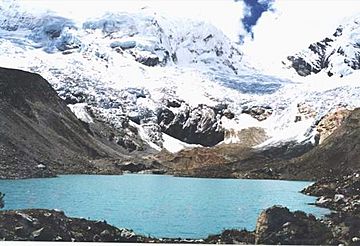Pucaranra facts for kids
Quick facts for kids Pucaranra |
|
|---|---|

Palcaraju (on the left) and Pucaranra (on the right) behind Lake Palcacocha
|
|
| Highest point | |
| Elevation | 6,147 m (20,167 ft) |
| Prominence | 2,903 m (9,524 ft) |
| Parent peak | Chinchey |
| Geography | |
| Location | Peru, Ancash Region |
| Parent range | Andes, Cordillera Blanca |
| Climbing | |
| First ascent | 07/04/1948 - B. Lauterburg, Federico Marmillod, R. Schmid and F. Sigrist (Switzerland) via S.W. spur of S. ridge
Variant on S.W. side-1954 E. slopes-1957: N.E. ridge-1959 S.W. ridge, S.W. face-1965 W. ridge-1977 |
| Easiest route | southeast ridge, AD |
Pucaranra is a tall mountain in the Andes mountains of Peru. Its name might come from the Quechua language. Puka means red, and ranra means stony ground. So, Pucaranra could mean "red stony ground."
This mountain is about 6,147 meters (20,167 feet) high. It is part of the Cordillera Blanca mountain range. Pucaranra is located in the Ancash Region of Peru. It stands southwest of another mountain called Chinchey.
Pucaranra is inside the Huascarán National Park. This park helps protect the amazing nature in the area. The mountain is on the border of two provinces: Carhuaz Province and Huaraz Province.
First Climb
The first time people successfully climbed Pucaranra was on April 7, 1948. A team of four climbers from Switzerland made the first ascent. They were B. Lauterburg, Federico Marmillod, R. Schmid, and F. Sigrist. They climbed the mountain using a path on the southwest side of its south ridge.
Mountain Climbing Routes
Pucaranra offers several exciting paths for climbers. These routes are not extremely difficult, but they do require skill and determination. Climbers can choose from different ways to reach the top.
- The east-northeast ridge is a popular climbing path.
- The southeast face is another challenging route.
- The southeast ridge is also a common choice for climbers.
Each route has its own unique features and challenges. Climbers need to be prepared for the conditions they might face.
See also
 In Spanish: Pucaranra para niños
In Spanish: Pucaranra para niños


